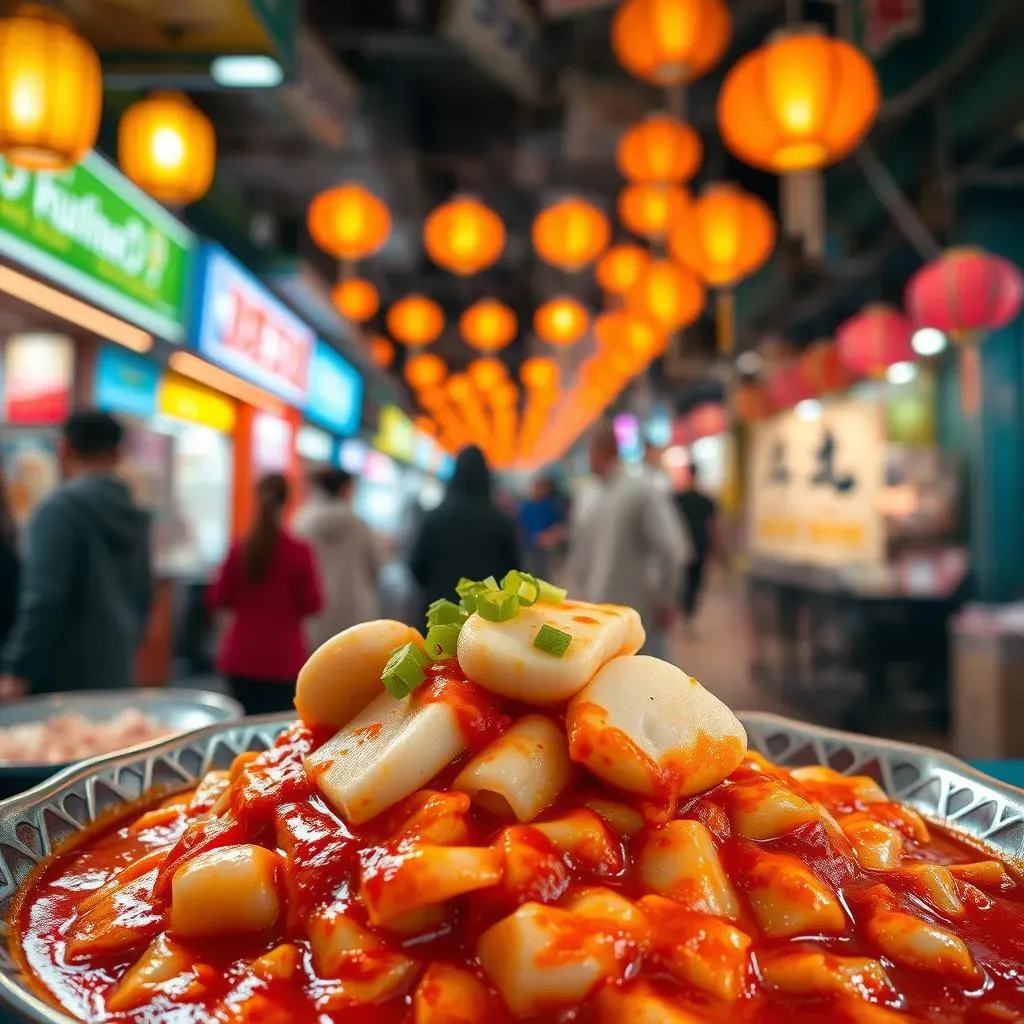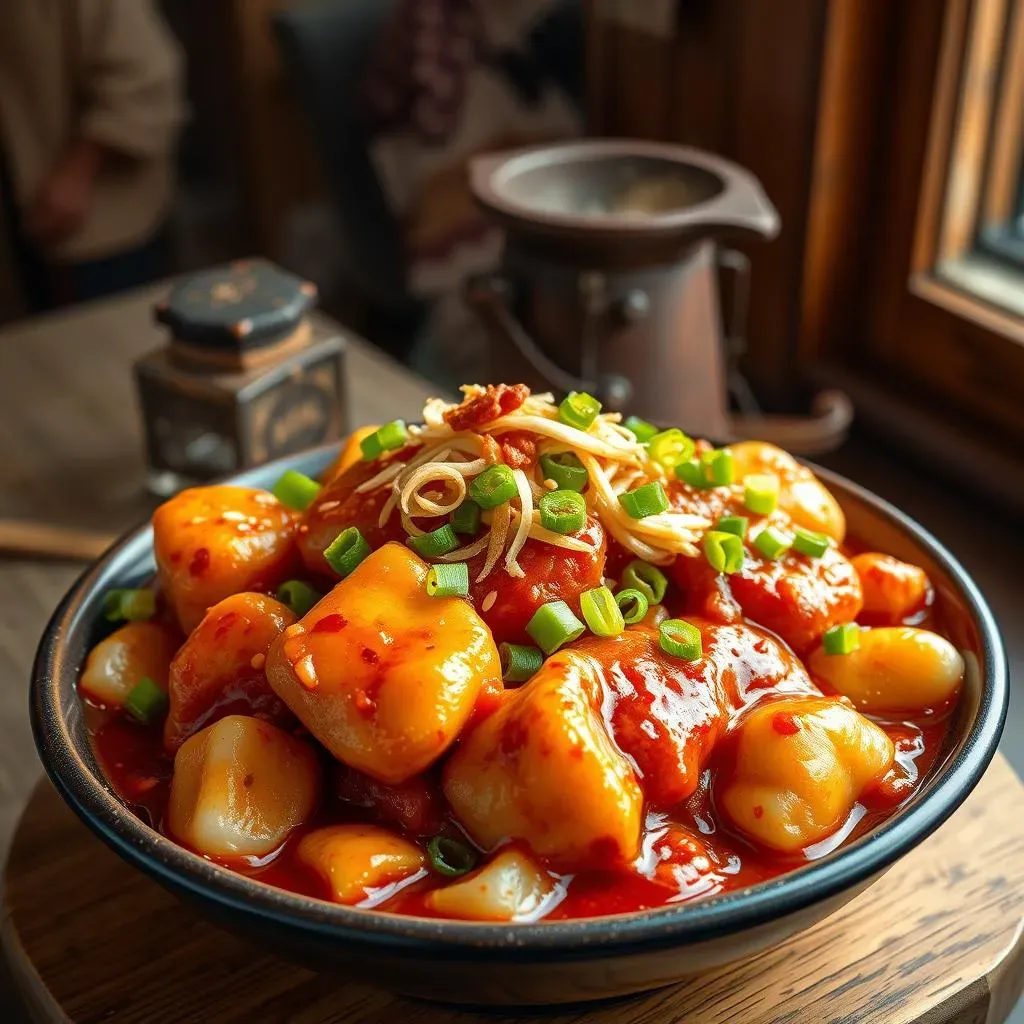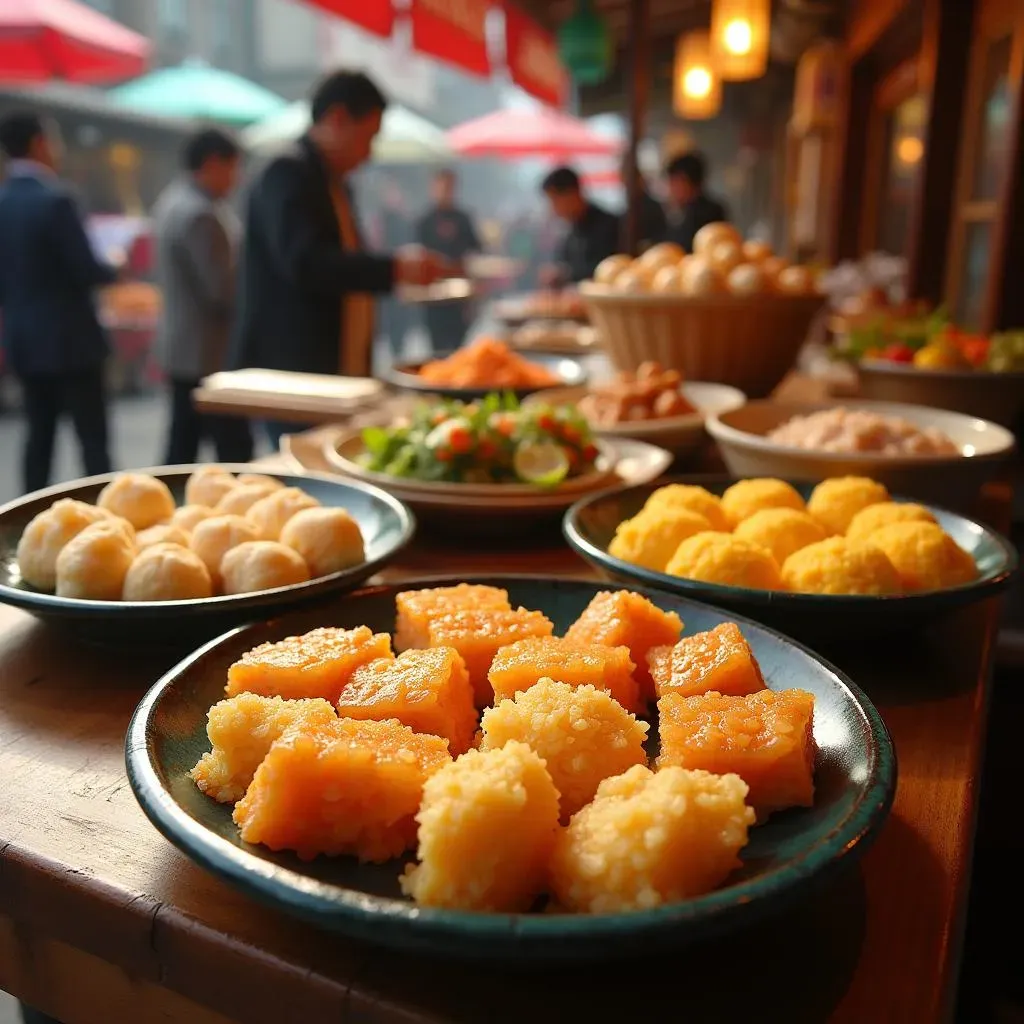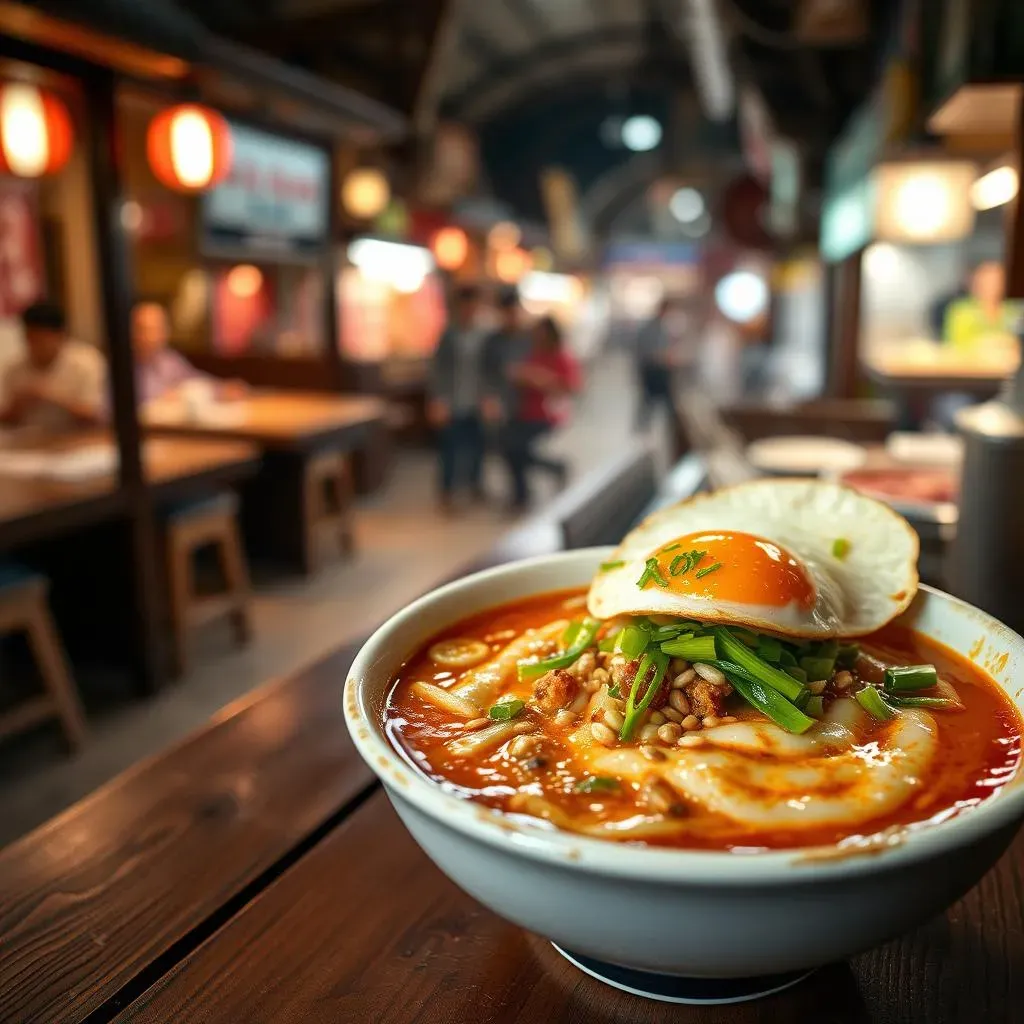Table of Contents
Get ready for a culinary adventure! This article is your passport to the vibrant world of Korean rice cake street food. We'll explore the chewy, spicy sensation that is tteokbokki, the star of countless street food stalls and home kitchens. But tteokbokki is just the beginning. We'll uncover the secrets behind its addictive flavor, delve into the history and cultural significance of this beloved dish, and reveal a range of exciting variations, from sweet to super spicy. Whether you're a seasoned foodie or a curious newcomer, prepare to be amazed by the diversity and deliciousness of Korean rice cake street food. This journey will equip you with the knowledge to appreciate, and maybe even recreate, these culinary treasures. So, let's dive in and discover why Korean rice cake street food has captured hearts and taste buds around the globe!
What is Korean Rice Cake Street Food?
What is Korean Rice Cake Street Food?
The Star of the Show: Tteokbokki
Imagine this: you're strolling through a bustling Korean street market, the air thick with the aroma of sizzling food and lively chatter. Your eyes are drawn to a vibrant red sauce bubbling in a large pot, glistening with glistening oil. That, my friend, is likely tteokbokki, the undisputed king of Korean rice cake street food. It's the dish that often springs to mind when people think of Korean street food. These aren't your average rice cakes; they're cylindrical, chewy, and oh-so-satisfying.
Tteokbokki is made from garaetteok, soft, white rice cakes. These are then cooked in a spicy, sweet, and savory sauce, often featuring gochujang (Korean chili paste) and gochugaru (Korean chili flakes) for that signature fiery kick. But the magic doesn't stop there! Fish cakes (eomuk), vegetables like cabbage and onions, and sometimes even eggs or cheese are frequently added to the mix, creating a symphony of textures and flavors.
Ingredient | Role in the Dish |
|---|---|
Garaetteok (Rice Cakes) | Provides the chewy, satisfying base. |
Gochujang (Chili Paste) | Adds depth of flavor and signature spiciness. |
Gochugaru (Chili Flakes) | Boosts the heat and adds visual appeal. |
Eomuk (Fish Cakes) | Adds a savory, umami element and textural contrast. |
Beyond the Basics: Variety is the Spice of Life
While tteokbokki reigns supreme, the world of Korean rice cake street food extends far beyond this iconic dish. Think of it as a vast and delicious culinary playground! You'll find variations on tteokbokki itself, some with a sweeter profile, others amping up the spice to a whole new level. There are also countless other rice cake preparations, each boasting unique flavors and textures.
For example, you might encounter tteok-kkochi, rice cakes on skewers, often grilled and glazed with a sweet and savory sauce. Or perhaps you'll stumble upon a bowl of warm, comforting tteokguk, a rice cake soup, perfect for a chilly day. The possibilities are practically endless, showcasing the versatility of rice cakes as a culinary canvas.
- Tteokbokki (spicy stir-fried rice cakes)
- Tteok-kkochi (rice cake skewers)
- Tteokguk (rice cake soup)
- Gimbap (seaweed rice rolls with rice cakes)
- Sundae (blood sausage often served with rice cakes)
A Cultural Icon: More Than Just a Snack
Korean rice cake street food isn't just about delicious food; it's deeply intertwined with Korean culture. These dishes are often associated with festivals, celebrations, and everyday life. They represent a connection to tradition and community, offering a simple yet deeply satisfying experience.
The vibrant street food scene itself is a testament to Korean culture’s emphasis on community and sharing. It's a place where people gather, socialize, and enjoy delicious food together. The dishes are affordable and accessible, making them a beloved part of everyday life for many Koreans.
The Irresistible Taste of Tteokbokki: A Deep Dive
The Irresistible Taste of Tteokbokki: A Deep Dive
The Magic of the Sauce: A Flavor Symphony
So, what makes tteokbokki so irresistible? It's all about that sauce, my friend! It's a complex blend of sweet, spicy, and savory notes that dance on your tongue. The base typically involves gochujang, that deep red Korean chili paste. It's what gives the sauce its rich, umami depth. Then comes the gochugaru, Korean chili flakes, which add a fiery kick and beautiful red color. Think of it as the perfect balance of sweet and heat. The secret weapon, though, often lies in the addition of other ingredients like soy sauce, sugar, and even a touch of fish sauce for that extra umami punch. This is where the real magic happens – the way these flavors intertwine to create something truly special.
The sauce isn't just about taste; it's also about texture. It's thick, coating every chewy rice cake perfectly. It's a delightful contrast to the soft, pillowy texture of the garaetteok. And it's wonderfully versatile. Some versions lean more towards the sweet side, others are brutally spicy. Some cooks add a touch of garlic or ginger for extra depth, while others incorporate a dash of sesame oil for a nutty aroma. The possibilities are endless, and that's part of what makes tteokbokki so captivating.
Sauce Ingredient | Flavor Contribution |
|---|---|
Gochujang | Umami depth, savory spiciness |
Gochugaru | Fiery heat, vibrant color |
Soy Sauce | Saltiness, savory balance |
Sugar | Sweetness, counterpoint to spice |
More Than Just a Sauce: The Full Tteokbokki Experience
But the sauce isn't the only thing that makes tteokbokki so special. The rice cakes themselves are key. That signature chewy texture is a delight in itself. Then there are the additions. Fish cakes (eomuk) add a savory, almost seafood-like flavor and a pleasingly bouncy texture. Think of them as little savory clouds. Sometimes, vegetables like onions and cabbage are added to provide a fresh counterpoint to the richness of the sauce. And then there are the optional extras – a fried egg adds richness and a creamy yolk to break into, while melted cheese adds a gooey, stretchy element.
The beauty of tteokbokki is its adaptability. It's a dish that can be customized to your liking. Want it spicier? Add more gochugaru. Prefer a sweeter profile? Add a little extra sugar. Want a vegetarian version? Substitute the fish cakes for tofu or mushrooms. The fundamental elements remain, but the possibilities for creative variations are almost limitless. It's a dish that invites experimentation and personal expression.
- Chewy Garaetteok (Rice Cakes)
- Savory Eomuk (Fish Cakes)
- Optional additions: Egg, Cheese, Vegetables
- Spice level: Adjustable to your preference
Beyond Tteokbokki: Exploring Other Korean Rice Cake Delights
Beyond Tteokbokki: Exploring Other Korean Rice Cake Delights
Sweet and Savory Skewers: Tteok-kkochi
While tteokbokki steals the show, don't overlook tteok-kkochi, delightful rice cakes on a stick! These aren't just plain rice cakes; they're often marinated or glazed, offering a sweet and savory explosion in every bite. Imagine tender rice cakes, grilled to perfection, then brushed with a sticky-sweet gochujang-based sauce, maybe with a hint of soy sauce and sesame oil for extra depth. Sometimes, they’re even coated in a crispy, almost tempura-like batter before grilling, adding another layer of textural interest. You'll find these at many street food stalls, often alongside other grilled delights.
The beauty of tteok-kkochi lies in its portability and the sheer variety of flavors you can find. Some vendors offer classic sweet and savory options, while others experiment with more adventurous combinations, incorporating spices, herbs, or even bits of meat or seafood into the marinade. It's a fantastic way to sample different flavor profiles in a convenient, on-the-go format. They're perfect for a quick snack or a light meal, offering a delicious and satisfying bite-sized treat.
Tteok-kkochi Variation | Key Flavor Profile |
|---|---|
Classic Sweet & Savory | Balanced sweetness and savory notes from gochujang and soy sauce |
Spicy Gochujang | Intense heat and savory depth from a spicier gochujang base |
Sweet & Spicy with Sesame | Sweet and spicy with a nutty aroma from sesame oil |
A Hearty Bowl of Comfort: Tteokguk
Now, let's talk about tteokguk, a Korean rice cake soup that's the epitome of comforting warmth. Unlike the fiery tteokbokki, tteokguk offers a gentler, more nuanced flavor profile. It's a clear broth, often made with beef or seafood, simmered with garaetteok rice cakes until they're soft and tender. The broth itself is often seasoned with soy sauce, salt, and sometimes a touch of sesame oil for a subtle nutty flavor. This isn’t just a simple soup; it’s a celebration of textures, with the soft rice cakes contrasting beautifully with any added ingredients.
Tteokguk is often enjoyed during special occasions, particularly on New Year's Day, symbolizing new beginnings and good fortune. The number of rice cakes in a bowl is even said to be symbolic of one's age in the new year! Beyond its cultural significance, though, tteokguk is simply a delicious and satisfying meal. It's hearty, flavorful, and perfect for a chilly day or a comforting lunch. You might find variations that include vegetables, eggs, or even thinly sliced meat, all adding to the overall richness and complexity of the dish.
- Beef Tteokguk: Rich beef broth with tender rice cakes.
- Seafood Tteokguk: Savory seafood broth with delicate rice cakes.
- Vegetarian Tteokguk: Vegetable broth with various vegetables and rice cakes.
Beyond the Usual Suspects: Other Rice Cake Delights
The culinary creativity with rice cakes doesn't stop there! Korea boasts a wealth of other dishes featuring these versatile ingredients. Consider the many variations of japchae, a glass noodle dish that often includes rice cakes for added chewiness and texture. Or imagine the delightful crunch of rice cakes added to a bibimbap, the colorful mixed rice bowl. Even seemingly unrelated dishes might surprise you with a hidden rice cake element. They might be thinly sliced and incorporated into pancakes or added to savory stews for a unique textural contrast. The possibilities are remarkably diverse.
Exploring these lesser-known rice cake dishes is like uncovering hidden culinary gems. Each dish offers a unique flavor profile and textural experience, showcasing the versatility of rice cakes in Korean cuisine. It's a testament to the ingenuity of Korean chefs and the cultural significance of these humble yet extraordinary ingredients. By venturing beyond the familiar, you'll discover a whole new level of appreciation for the rich and diverse world of Korean rice cake cuisine.
Making Korean Rice Cake Street Food at Home: Recipes and Tips
Making Korean Rice Cake Street Food at Home: Recipes and Tips
Tteokbokki Triumphs: A Beginner-Friendly Recipe
Let's start with the king: tteokbokki! Don't be intimidated; making this at home is easier than you think. You'll need garaetteok (rice cakes), gochujang (Korean chili paste), gochugaru (Korean chili flakes), soy sauce, sugar, and optionally, fish cakes (eomuk) and vegetables. Soak the rice cakes in warm water to soften them, then stir-fry them in a little oil until slightly browned. In a separate pan, whisk together your sauce ingredients – you can find countless recipes online to adjust the spice level to your liking. Pour the sauce over the rice cakes, simmer until thickened, and enjoy!
Remember, the key is to find a balance of sweet and spicy. Don't be afraid to experiment with the sauce ingredients to find your perfect ratio! And don't forget the toppings! A fried egg, some sesame seeds, or even a sprinkle of chopped green onions can elevate your homemade tteokbokki to the next level. Serve it hot, and prepare for a flavor explosion!
Ingredient | Amount (adjust to taste) |
|---|---|
Garaetteok (Rice Cakes) | 1 cup (approx. 200g) |
Gochujang (Chili Paste) | 2 tablespoons |
Gochugaru (Chili Flakes) | 1 tablespoon |
Soy Sauce | 1 tablespoon |
Sugar | 1 tablespoon |
Beyond Tteokbokki: Exploring Other Rice Cake Recipes
Once you've mastered tteokbokki, why not branch out? Tteok-kkochi, those delightful rice cake skewers, are surprisingly simple to make. Marinate your rice cakes in a mixture of gochujang, soy sauce, honey, and sesame oil. Thread them onto skewers, and grill them until slightly charred and caramelized. The result? A sweet and savory treat that's perfect for a quick snack or appetizer. You can even add some vegetables to the skewers for extra flavor and visual appeal. Get creative and experiment with your marinade ingredients!
For a comforting bowl of warmth, try making tteokguk, a Korean rice cake soup. This dish is a perfect example of how simple ingredients can create a truly satisfying meal. Start with a flavorful broth (beef or vegetable), add your softened rice cakes, and simmer until tender. Season with soy sauce, salt, and a touch of sesame oil. You can add other ingredients such as sliced meat, vegetables, and a poached egg. The beauty of tteokguk lies in its simplicity and versatility; you can customize it to your heart's content!
- Tteok-kkochi Tip: Marinate the rice cakes for at least 30 minutes for maximum flavor.
- Tteokguk Tip: Use a good quality broth for the best flavor.
- General Tip: Don't overcook the rice cakes; they should be soft but still have a slight chewiness.
Troubleshooting and Tips for Success
Making Korean rice cake dishes at home can be a rewarding experience, but there might be a few hurdles along the way. One common issue is overcooking the rice cakes, which can result in a mushy texture. Remember to follow the instructions carefully and adjust cooking times according to your stovetop. If you're using dried rice cakes, make sure to soak them properly before cooking to prevent them from becoming too hard. Another potential problem is achieving the right balance of flavors in your sauce. Start with a basic recipe and then adjust the amounts of each ingredient to your taste. Don't be afraid to experiment!
Remember, the beauty of these dishes is their versatility. Feel free to experiment with different ingredients and flavor combinations to create your own unique versions. Add some kimchi for extra spice and tang, or incorporate other vegetables for added nutrients. The possibilities are endless! Don't be afraid to get creative and have fun with it. The most important thing is to enjoy the process and the delicious results. After all, cooking should be a joyful experience!